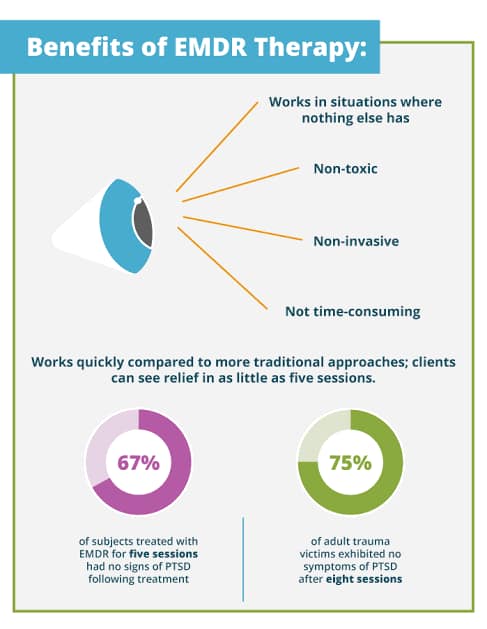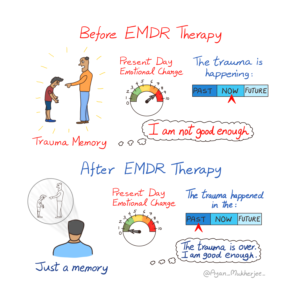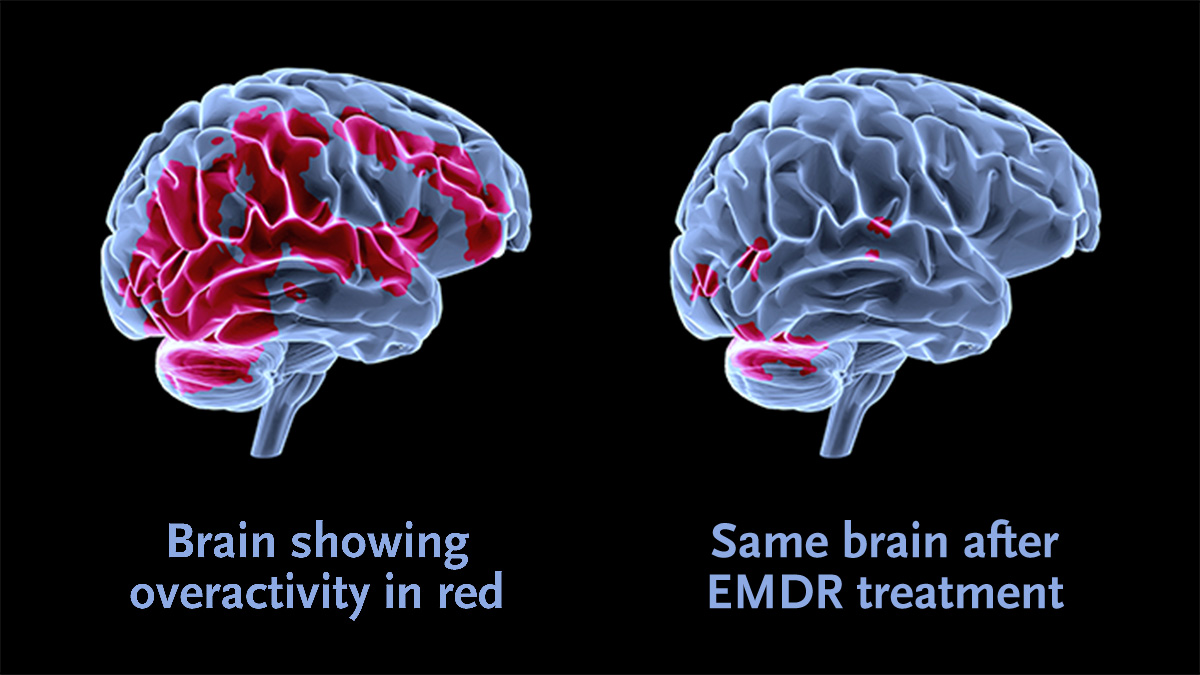This is the first of a two-part series on EMDR (Eye Motion Desensitization and Reprocessing) Therapy. Part 1 will provide information on what the therapy does and why it is so effective. Part 2 will provide my personal experience with EMDR as well as a transcript of an EMDR session.
What would you give to be relieved of a burden you’ve been carrying for many years? There are those among us who are able to live in the present moment. Who are able to adapt, absorb and keep the things that happen to them in perspective. Then are the rest of us, who have been negatively shaped by the blows life dealt them. Those who have been trying to rid themselves of behaviors they dislike, who struggle to forgive, who have developed magical thinking (I can’t look forward to an event because it will lead to being hurt when it is over/ I can’t let myself feel happy without triggering cosmic disaster/ I need to hold constant vigilance over my child as this will prevent any harm from coming to them.) People who feel a constant baseline of anxiety, people who had a genetic disposition to depression and that became triggered at a young age. There are those who spend a large part of each day thinking about the past or worrying about the future. One of these people is me. What would you give to be relieved of it?
I’d never heard of EMDR Therapy before about a year ago. My past 4 years had been very turbulent and trying. I had encountered a life threatening illness, major surgery, issues with both of my children, chronic health problems and a multi-state move. I had begun working with a therapist about this while recovering from my surgery. The illness itself had deeply shaken my sense of personal safety. In a very short period of time, I had gone from being a healthy, active person who had a full life to a person who lived in constant fear of going unconscious from low blood sugar. My entire life’s focus revolved around the number on my glucose monitor. The realization of how quickly health could be taken away, how quickly it could change everything, was a harsh thing to accept. The surgery to correct my condition (a neuroendocrine tumor of the pancreas) was the largest abdominal surgery possible. Without this surgery, I would not be alive today. But that made is no less terrifying to undergo. It took a full year to recover physically from the surgery, then the long process of emotional healing began.
Things got worse with our move. It had come at the worst possible time for me, emotionally. It was heartbreaking to leave the home where we had raised our children. When we left Alton, before I even went to our new home in Florida, I took our oldest to college, states away, knowing we would not see each other again for months. Although I still had my friends, I was now physically separated from my support system and this destabilized me further. I’d also left the support of my therapist which was one more blow to my stability. The coping mechanisms I’d been using through all this began making me even more miserable. A few additional life events post-move was all it took to bring me down completely. I sought the help of a therapist to start untangling myself again.
The new therapist and I were a good fit. We made progress. The more events from my past came up, the more she suggested EMDR as a course of treatment. She felt it could be very effective in re-consolidating past events that were still causing me pain and neutralize the ways they were influencing my day to day life. I must admit, when she described the process to me, I nodded my head but wondered if she was proposing something along the lines of voodoo or essential oils for all that ailed me. It sounded ‘out there’, to say the least. Each time I describe this process to someone now I always preface it with – I know how this sounds BUT hear me out. I agreed to try it. There was no harm in seeing if it was effective in helping me.
It was very effective, as it turned out. In fact, in each 90 minutes of EMDR I saw results equal to six months of talk therapy. I have become a huge proponent of EMDR and have recommended it to many people as a fast-paced model to combat anxiety, depression, change trauma responses and let go of the past.

What is EMDR Therapy?
EMDR stands for Eye Motion Desensitization and Reprocessing. Our minds have a natural process for dealing with stress, finding solutions and processing trauma. This process is sleep. Specifically, the REM (Rapid Eye Movement) phase of sleep, in which we dream. Dreams are often nonsensical, as our brains sift through the events of that day and other things that are going on in our lives. If you’ve ever gone to sleep with something on your mind and have woken up with the solution, this process was at play. If you’ve ever gone to bed upset about something and woke up feeling better, this process was at play there too. EMDR Therapy mimics the process of dreaming and sleep, but since we are awake and alert, we are able to discuss the things our minds are sifting through, gain new insights immediately and see any new viewpoints they provide.
EMDR was developed in 1989 by Francis Shapiro, a psychologist who was researching a mind-body connection as it applied to cancer recurrence. A cancer survivor herself, she was working on a theory that linked distress to the phenomenon of some people experiencing recurrence while others did not. Almost by accident, she was on a walk with something troubling her and noticed her distress level had become greatly reduced all of a sudden. Retracing her steps to figure out what had taken place, she noted that her eyes had been moving in a back and forth motion, observing her surroundings, during the walk. She was able to duplicate these results in a lab setting using the same eye motions. She then began testing it on others with similar results. She moved on to clinical trials, working with sexual assault survivors and war veterans. PTSD, as it applies to war veterans, is a huge problem. Nothing at the time was working very effectively on these people’s PTSD, yet many began to see results with the EMDR model.
In a perfect world, our brains would work on a trauma until it was fully processed and caused no residual emotion or lingering negative thoughts about ourselves or life in general. Many of the traumas we experience ARE processed in this way. A few weeks ago, I discussed my trauma of a violent physical assault and how, in the aftermath, I was able to work through it effectively. https://intothegloaming.com/a-tale-of-two-traumas/ It is now just an experience that happened to me. It has had no lasting effects on my life. I feel no emotion discussing it. For whatever reason, lesser things have happened to me that were not processed as my assault was. These experiences have continued to disrupt my life in the form of negative thoughts, unhealthy coping mechanisms, self-fulfilling prophesies and anxiety.
How memories are processed with EMDR

In an EMDR therapy session, a therapist will access a disturbing memory, jump-start the brains processing system through Rapid Eye Movement simulation, then monitor the effects. REM simulation can be achieved in one of several ways. Traditionally, the patient will follow the therapists’ finger with their eyes for a period of 30 seconds. This can also be done with headphones that beep on alternating sides, or tappers, sensors held in each hand that take turns vibrating. I tried all these methods out but was most comfortable with the tappers and that is what I’ve stuck with.
In the 30 second “processing” portion of EMDR, the brain makes internal connections to other events or memories associated with the original one. The new connections and additional experiences create a bigger picture that can offer new insights. For instance I had a trauma memory of being informed via phone call that I was miscarrying an in-vitro pregnancy. I had gone through a lot to make that pregnancy possible. Had found the money, had gone back for these frozen embryos that I felt a responsibility to. My overwhelming feeling on that particular day was “I am so gullible and stupid. Look at what I went through for nothing.” I felt I had followed what God wanted for me at that time (in fact, that experience destroyed what little belief I had left in God.) It was a big deal. It changed a lot of beliefs I held in how the world worked. When I saw myself on this day, again, in EMDR, I could see myself standing exactly where I was that day, on the phone. I can remember what I was wearing. I remember what my room looked like that day, before several remodels. In the new version, though, I said – “I was so brave to do that. Look how strong and determined I was. It was no less than I would do for any of my children. I had the strength to go through that even knowing this was a possible outcome.” These new insights were integrated into that memory. Instead of remaining a source of pain and proof of my gullibility, I had a new admiration at the strength and determination I showed. Instead of a gullible, weak woman, I saw a woman who would do whatever she had to do for her children.
Very significant changes can take place during an EMDR session, as your childhood traumas are layered with your adult point of view. New messages can replace the old ones, permanently. During one session, after many memories that seemed to prove the belief that I was an inherently bad person, my therapist asked me to come up with a positive statement about myself instead. I said “I have always made the best decisions I could at the time, with the information I had available.” She then processed that in and I went through the whole sequence backwards adding the new belief into each memory. When I walked out of her office that day, it was a rewritten hard drive. Each place that had been written with “I’m a bad person” had been re-coded with “I’ve always done the best I could.” Imagine 40 years of the recurrent belief of “I’m a bad person” being transformed in 90 minutes time. You might think I walked out of that office feeling light as air. And, you would be right.
Join me next week for You Should See Me In A Crown: On EMDR Therapy Part 2, in which I will be sharing the transcript of one of my EMDR sessions and describing the effects it has had on my life journey, overall.


Thanks for your thoughtful writing! Looking forward to the next one! I discovered EMDR several years ago along with my husband and it saved our marriage!! He was “cured” in just a few sessions; however my severe developmental wounding from childhood has caused me great distress through life along with EMDR taking much longer(I have no memory of my childhood, making it difficult)! It is a life saver for anyone whom has had traumatic experiences!